Trichophyton rubrum - Clinical Manifestation
Clinical Manifestation of Trichophyton rubrum
Clinical manifestations of Trichophyton rubrum infection include:
Tinea pedis
Tinea unguium
Tinea manuum
Tinea cruris
Tinea corporis
Tinea barbae
Folliculitis
Extensive granuloma – mostly in immunocompromised (eg Cushing syndrome)
Id reaction
Tinea pedis
tinea pedis, also known as athlete's foot, is a common clinical manifestation of Trichophyton rubrum infection
infection of the foot, toes, interdigital web spaces
warmth and moisture produced by the shoes aid in establishing and maintaining infection
commonly seen in individuals wearing shoes for long hours
symptoms include itching, scaling, cracking, redness, and in rare cases skin blisters to ulcerative
although any area of the foot may be infected, areas between toes are most commonly infected
chronic cases may result in the moccasin foot in which the entire foot forms white scaly patches
the moccasin foot is mostly asymptomatic with slightly erythematous plaques on the sole of the foot and is covered by hyperkeratotic scales
can be divided into four categories -
* chronic interdigital
* plantar (moccasin foot)
* acute ulcerative
* vesiculobullous

Tinea pedis (Source: Clear Skin)
Chronic interdigital
most common
occurs between toes
syndromes include maceration, fissuring erythema, scaling in toe webs
mostly found between the fourth and fifth toes
Plantar (moccasin foot)
also known as a moccasin foot or hyperkeratotic
occurs on the sole of the foot i.e. plantar and lateral surfaces
associated with scaling or hyperkeratosis
Acute ulcerative
usually affects the soles of the feet
associated with maceration, denudation, oozing (pus) of the skin
macerated lesions with scaly borders
Vesiculobullous
less common mucocutaneous disease
characterized by vesicles (less than 5-10mm), bullae (blisters) (larger than 5-10mm) formation
these vesicles and bullae are fluid-filled lesions
occurs near the instep and adjacent plantar surface
pustules, which are sometimes formed, are small with clear vesicles
Complications of tinea pedis
In chronic cases, the skin may crack leading to bacterial skin infection and inflammation of the lymphatic vessels (lymphangitis, lymphadenitis). Trichophyton rubrum may also spread to infect the toenails resulting in a condition known as onychomycosis.
If the host develops a scratch reflex, it may lead to self-inflicted excoriations, and if not immediately washed, it may spread to other body parts/people or even infect nails.
Tinea unguium
Trichophyton rubrum is one of the causative agents of tinea unguium
also known as Distal subungual onychomycosis
fungal infection of the nail (toenail or fingernail)
invades the nail bed and underside of the nail plate
symptoms include white, black, green, or yellow nail discoloration, thickening of the nail, separation of the nail from the nail bed
in chronic cases, nails may become brittle with pieces or whole nails breaking off
in untreated cases, the skin underneath and around the nail can become inflamed and painful
no pain or other bodily symptoms unless the disease is severe
does not necessarily require treatment but oral antifungal medicine is effective (associated with liver problems)
Complications of tinea unguium
The complication of tinea unguium, caused by Trichophyton rubrum, is cellulitis.
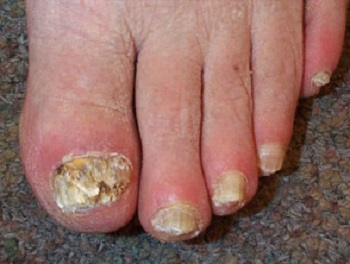
Tinea unguium (Source: dermnetnz)
Tinea manuum
tinea manuum, caused by Trichophyton rubrum, is a fungal infection of the hand
maybe caused by transmission from other fungal infections such as athlete's foot or tinea cruris
scaling is diffused on the palms or back and each rash looks different
more prominent palmer creases which appear white in chronic cases
nails may also be infected
maybe itchy, look slightly raised with dry flaky thick skin on hand’s palm
in cases where the back of the hands are infected, reddish circles resembling ringworm are present
mostly only one hand is affected but Trichophyton rubrum infection may occur on both hands
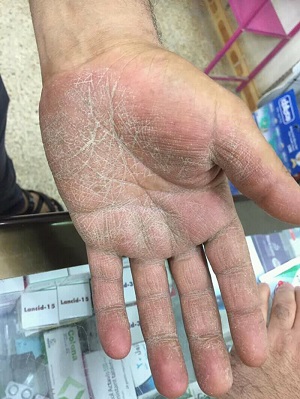
Tinea manuum (Source: Wikipedia)
Tinea cruris
tinea cruris, caused by Trichophyton rubrum, is also known as jock itch, ringworm of the groin, scrot rot, eczema marginatum, gym itch, crotch itch
it is a superficial fungal infection of the groin (upper inner thighs), and buttocks which is contagious and occurs predominantly in hot-humid climates
symptoms include intense itchy red rash with a raised, scaly, and well-defined curved border
may have some blistering, and weeping, with light colored center
the rash may appear as flaking, peeling, iridescence, cracking, rippling skin which may appear tan, brown, or reddish in color
hair follicles may also be involved resulting in papules, nodules, and pustules within the plaque
in chronic cases, these plaques may reach the scrotum in men, mons pubis, and labia majora in women
in the case of individuals using steroids for immunosuppression, the penis may also be affected
the infection may also extend to the anus
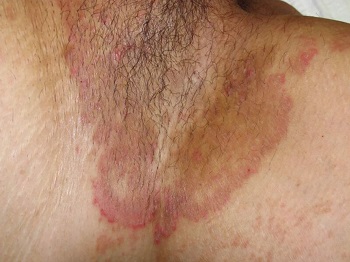
Tinea cruris (Source: Health Jade)
Tinea corporis
tinea corporis, caused by Trichophyton rubrum, is a fungal infection of the body – the arms and legs
more common on glabrous skin i.e. where there is a lack of hair but may occur on any superficial part of the body
marked by enlarging raised red rings with a light central area (ringworm_
symptoms include itching, an elevated rash with scaly touch, hair loss in the infected area
the skin surrounding the rash appears dry and flaky
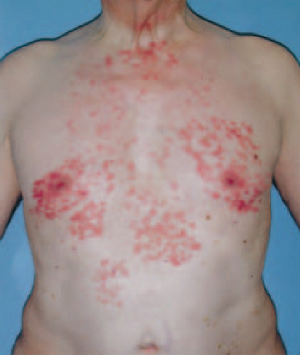
Tinea corporis (Source: Semantic Scholar)
Tinea barbae
tinea barbae, caused by Trichophyton rubrum, is the fungal infection of the hair around the bearded area
clinically manifests as a cutaneous granulomatous lesion (chronic inflammatory reaction) or a follicular inflammation
an important cause of folliculitis
most common among agricultural workers (animal-to-human transmission)
human to human transmission is less common
affected area manifests as a pimple or blister, swelling and redness, and lumpy skin with crusting around hairs in the infected area
in some cases, can be itchy and painful
hairs on the infected area are effortless to pull out
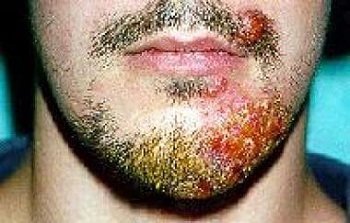
Tinea barbae (Source: Medscape Reference)
Folliculitis
Trichophyton rubrum infection may result in folliculitis
may occur anywhere on hair-covered skin
the condition appears as pimples with white tips
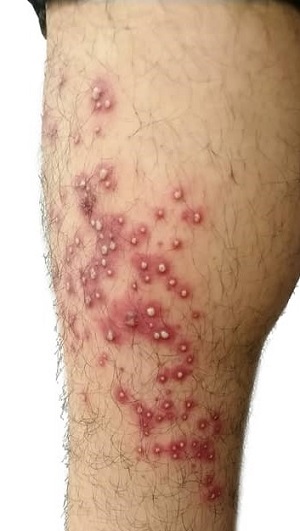
Folliculitis (Source: Super Pharmacy)
Id reaction
The infected individual becomes hypersensitive to constituents of Trichophyton rubrum and may develop dermatophytids. Dermatophytids are allergic manifestations associated with vesicles of the fingers and elsewhere on the body, especially the hands.
This condition is a response to circulating fungal antigens and the lesions do not contain fungal hyphae. Trichophytin skin test can detect this reaction.